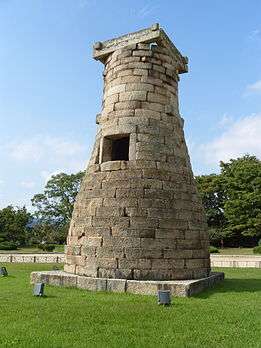Cheomseongdae
Coordinates: 35°50′11″N 129°13′18.4″E / 35.83639°N 129.221778°E
| Cheomseongdae | |
 | |
| Korean name | |
|---|---|
| Hangul | 첨성대 |
| Hanja | 瞻星臺 |
| Revised Romanization | Cheomseongdae |
| McCune–Reischauer | Ch'ŏmsŏngdae |
Cheomseongdae is an astronomical observatory in Gyeongju, South Korea. Cheomseongdae means star-gazing tower in Korean. Cheomseongdae is the oldest surviving astronomical observatory in Asia,[1][2][3] and possibly even the world.[4][5][6] It was constructed in the 7th century in the kingdom of Silla, whose capital was Seorabeol, or present-day Gyeongju. Cheomseongdae was designated as the country's 31st national treasure on December 20, 1962.[7]
Overview
According to Samguk Yusa, Cheomseongdae was constructed under the reign of Queen Seondeok (632-647) near the capital of the kingdom. Cheomseongdae means "star gazing platform". The tower is built out of 362 pieces of cut granite which some claim represent the 362 days of the lunar year. [8] It has 27 circular layers of stones (some associate it with the fact that Queen Seondeok was considered to be the 27th ruler of Silla or the constellation of stars) surmounted by a square structure. 12 of the layers are below the window level and 12 are above. There are 12 large base stones set in a square, with three stones on each side. These sets of 12 may symbolize the months of the year.
The tower is 5.7 meters wide at the base and 9.4 meters tall, and filled with earth up to the level of the window. Its construction style parallels that used at the Bunhwangsa Temple in Gyeongju.

Popular Culture
Cheomseongdae is mentioned in popular 2009 Korean drama Queen Seondeok. In this drama, Cheomseongdae was constructed when Queen Seondeok was still a princess; this was her first decree as a princess. Cheomseongdae was meant to share the knowledge of astronomy with everyone, rather than letting one person (Lady Misil) abuse the knowledge of it. By doing so, she also abdicated her divine rights. Because this was uncommon at the time and unsupported by many conservatives, at the opening of Cheomseongdae, barely any nobles showed up.
Gallery
 A rainy view
A rainy view A night view
A night view
Notes
- ↑ Storey, Glenn. Urbanism in the Preindustrial World: Cross-Cultural Approaches. University of Alabama Press. p. 201. ISBN 9780817352462. Retrieved 16 November 2016.
- ↑ Dicati, Renato. Stamping Through Astronomy. Springer Science & Business Media. p. 30. ISBN 9788847028296. Retrieved 16 November 2016.
- ↑ Bernardi, Gabriella. The Unforgotten Sisters: Female Astronomers and Scientists before Caroline Herschel. Springer. p. 40. ISBN 9783319261270. Retrieved 16 November 2016.
- ↑ Kelley, David H.; Milone, Eugene F. Exploring Ancient Skies: A Survey of Ancient and Cultural Astronomy. Springer Science & Business Media. p. 79. ISBN 9781441976246. Retrieved 16 November 2016.
- ↑ Pak, Ch?ang-b?m. Astronomy: Traditional Korean Science. Ewha Womans University Press. p. 63. ISBN 9788973007790. Retrieved 16 November 2016.
- ↑ Selin, Helaine. Encyclopaedia of the History of Science, Technology, and Medicine in Non-Westen Cultures. Springer Science & Business Media. p. 503. ISBN 9789401714167. Retrieved 16 November 2016.
- ↑ Indiana University Resources . Retrieved February 13th, 2006.
- ↑ Song (1983, p.17) cites the original 1962 survey of the site by Gyeongju National Museum director Hong Sa-jun, who found 366 blocks.
References
- Jeon, Sang-woon. (1998). A history of science in Korea. Seoul:Jimoondang. ISBN 89-88095-11-1
- Nha, Il-seong. Silla's Cheomseongdae. (2001) Korea Journal 41(4), 269-281 (2001)
- Song, Sang-Yong. A brief history of the study of the Ch'ŏmsŏng-dae in Kyongju; Korea Journal 23(8), 16-21 (1983)